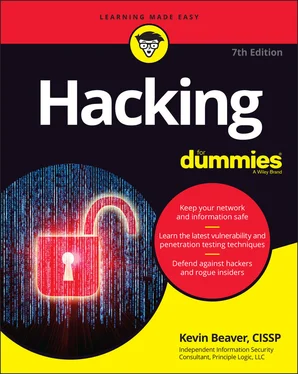Kevin Beaver - Hacking For Dummies
Здесь есть возможность читать онлайн «Kevin Beaver - Hacking For Dummies» — ознакомительный отрывок электронной книги совершенно бесплатно, а после прочтения отрывка купить полную версию. В некоторых случаях можно слушать аудио, скачать через торрент в формате fb2 и присутствует краткое содержание. Жанр: unrecognised, на английском языке. Описание произведения, (предисловие) а так же отзывы посетителей доступны на портале библиотеки ЛибКат.
- Название:Hacking For Dummies
- Автор:
- Жанр:
- Год:неизвестен
- ISBN:нет данных
- Рейтинг книги:3 / 5. Голосов: 1
-
Избранное:Добавить в избранное
- Отзывы:
-
Ваша оценка:
- 60
- 1
- 2
- 3
- 4
- 5
Hacking For Dummies: краткое содержание, описание и аннотация
Предлагаем к чтению аннотацию, описание, краткое содержание или предисловие (зависит от того, что написал сам автор книги «Hacking For Dummies»). Если вы не нашли необходимую информацию о книге — напишите в комментариях, мы постараемся отыскать её.
Hacking For Dummies
Hacking For Dummies
Hacking For Dummies — читать онлайн ознакомительный отрывок
Ниже представлен текст книги, разбитый по страницам. Система сохранения места последней прочитанной страницы, позволяет с удобством читать онлайн бесплатно книгу «Hacking For Dummies», без необходимости каждый раз заново искать на чём Вы остановились. Поставьте закладку, и сможете в любой момент перейти на страницу, на которой закончили чтение.
Интервал:
Закладка:
Other options include the SANS Global Information Assurance Certification (GIAC) program, IACRB Certified Penetration Tester (CPT), and the Offensive Security Certified Professional (OSCP) program, a hands-on security testing certification. I love the approach of the certifications, as all too often, people who perform this type of work don’t have the proper hands-on experience with the tools and techniques to do it well. See www.giac.org , www.iacertification.org , and www.offensive-security.com for more information.
Vulnerability and penetration testing versus auditing
Many people confuse security testing via vulnerability and penetration testing with security auditing, but big differences exist in the objectives. Security auditing involves comparing a company’s security policies (or compliance requirements) with what’s actually taking place. The intent of security auditing is to validate that security controls exist, typically by using a risk-based approach. Auditing often involves reviewing business processes, and in some cases, it isn’t as technical. Some security audits, in fact, can be as basic as security checklists that simply serve to meet a specific compliance requirement.
 Not all audits are high-level, but many of the ones I’ve seen — especially those involving compliance with the Payment Card Industry Data Security Standard (PCI DSS) and the Health Insurance Portability and Accountability Act (HIPAA) — are quite simplistic. Often, these audits are performed by people who have no technical security experience — or, worse, work outside IT altogether!
Not all audits are high-level, but many of the ones I’ve seen — especially those involving compliance with the Payment Card Industry Data Security Standard (PCI DSS) and the Health Insurance Portability and Accountability Act (HIPAA) — are quite simplistic. Often, these audits are performed by people who have no technical security experience — or, worse, work outside IT altogether!
Conversely, security assessments based on ethical hacking focus on vulnerabilities that can be exploited. This testing approach validates that security controls don’t exist or are ineffectual. This formal vulnerability and penetration testing can be both highly technical and nontechnical, and although it involves the use of formal methodology, it tends to be a bit less structured than formal auditing. Where auditing is required (such as for SSAE 18 SOC reports and the ISO 27001 certification) in your organization, you might consider integrating the vulnerability and penetration testing techniques I outline in this book into your IT/security audit program. You might actually be required to do so. Auditing and vulnerability and penetration testing complement one another really well.
Policy considerations
If you choose to make vulnerability and penetration testing an important part of your business’s information risk management program, you need to have a documented security testing policy. Such a policy outlines who’s doing the testing, the general type of testing that’s performed, and how often the testing takes place. Specific procedures for carrying out your security tests could outline the methodologies I cover in this book. You should also consider creating security standards documented along with your policy that outline the specific security testing tools used and the specific people performing the testing. You could establish standard testing dates, such as once per quarter for external systems and biannual tests for internal systems — whatever works for your business.
Compliance and regulatory concerns
Your own internal policies may dictate how management views security testing, but you also need to consider the state, federal, and international laws and regulations that affect your business. In particular, the Digital Millennium Copyright Act (DMCA) sends chills down the spines of legitimate researchers. See www.eff.org/issues/dmca for everything that the DMCA has to offer.
Many federal laws and regulations in the United States — such as the Health Insurance Portability and Accountability Act (HIPAA) and the associated Health Information Technology for Economic and Clinical Health (HITECH) Act, Gramm-Leach-Bliley Act (GLBA), North American Electric Reliability Corporation (NERC) Critical Infrastructure Protection (CIP) requirements, and the Payment Card Industry Data Security Standard (PCI DSS) — require strong security controls and consistent security assessments. There’s also the Cybersecurity Maturity Model Certification (CMMC). CMMC is a follow-on to NIST Special Publication 800-171 Protecting Controlled Unclassified Information in Nonfederal Systems and Organizations. This certification is intended to ensure that the U.S. Department of Defense’s (DoD’s) Defense Industrial Base (DIB) of suppliers/contractors are adequately protecting the DOD’s information assets.
Related international laws —such as the Canadian Personal Information Protection and Electronic Documents Act (PIPEDA), the European Union’s General Data Protection Regulation (GDPR), and Japan’s Personal Information Protection Act (JPIPA) — are no different. Incorporating your security tests into these compliance requirements is a great way to meet state and federal regulations and to beef up your overall information security and privacy program.
Understanding the Need to Hack Your Own Systems
To catch a thief, you must think like a thief. That adage is the basis of vulnerability and penetration testing. Knowing your enemy is critical. The law of averages works against security. With the increased number of hackers and their expanding knowledge and the growing number of system vulnerabilities and other unknowns, all computer systems and applications are likely to be hacked or compromised somehow. Protecting your systems from the bad guys —not just addressing general security best practices — is critical. When you know hacker tricks, you find out how vulnerable your systems really are and can take the necessary steps to make them secure.
Hacking preys on weak security practices and both disclosed and undisclosed vulnerabilities. More and more research, such as the annual Verizon Data Breach Investigations Report ( www.verizon.com/business/resources/reports/dbir/ ), shows that long-standing, known vulnerabilities are continually being targeted. Firewalls, advanced endpoint security, security incident and event management (SIEM), and other fancy (and expensive) security technologies often create a false feeling of safety. Attacking your own systems to discover vulnerabilities — especially the low-hanging fruit that gets so many people into trouble — helps you go beyond security products to make them even more secure. Vulnerability and penetration testing is a proven method for greatly hardening your systems from attack. If you don’t identify weaknesses, it’s only a matter of time before the vulnerabilities are exploited.
As hackers expand their knowledge, so should you. You must think like them and work like them to protect your systems from them. As a security professional, you must know the activities that the bad guys carry out, as well as how to stop their efforts. Knowing what to look for and how to use that information helps you thwart their efforts.
 You don’t have to protect your systems from everything. You can’t. The only protection against everything is unplugging your computer systems and locking them away so no one can touch them — not even you and especially not your users. But doing so is not the best approach to security, and it’s certainly not good for business! What’s important is protecting your systems from known vulnerabilities and common attacks — the 20 percent of the issues that create 80 percent of the risks, which happen to be some of the most overlooked weaknesses in most organizations. Seriously, you wouldn’t believe the basic flaws I see in my work!
You don’t have to protect your systems from everything. You can’t. The only protection against everything is unplugging your computer systems and locking them away so no one can touch them — not even you and especially not your users. But doing so is not the best approach to security, and it’s certainly not good for business! What’s important is protecting your systems from known vulnerabilities and common attacks — the 20 percent of the issues that create 80 percent of the risks, which happen to be some of the most overlooked weaknesses in most organizations. Seriously, you wouldn’t believe the basic flaws I see in my work!
Интервал:
Закладка:
Похожие книги на «Hacking For Dummies»
Представляем Вашему вниманию похожие книги на «Hacking For Dummies» списком для выбора. Мы отобрали схожую по названию и смыслу литературу в надежде предоставить читателям больше вариантов отыскать новые, интересные, ещё непрочитанные произведения.
Обсуждение, отзывы о книге «Hacking For Dummies» и просто собственные мнения читателей. Оставьте ваши комментарии, напишите, что Вы думаете о произведении, его смысле или главных героях. Укажите что конкретно понравилось, а что нет, и почему Вы так считаете.












